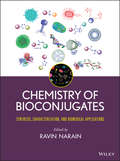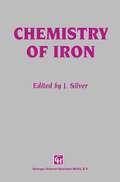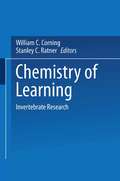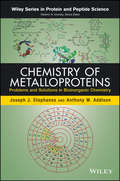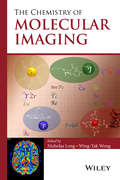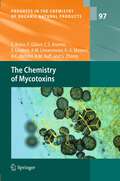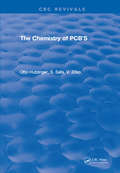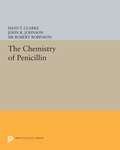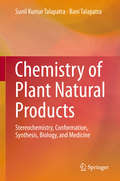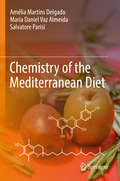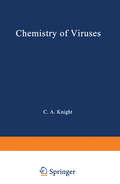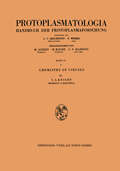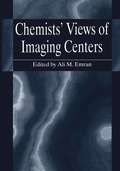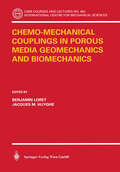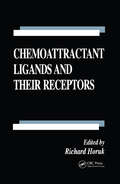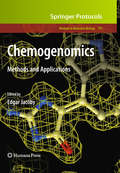- Table View
- List View
Chemistry of Bioconjugates: Synthesis, Characterization, and Biomedical Applications
by Ravin NarainExplores bioconjugate properties and applications of polymers, dendrimers, lipids, nanoparticles, and nanotubes Bioconjugation has enabled breakthroughs across many areas of industry and biomedicine. With its emphasis on synthesis, properties and applications, this book enables readers to understand the connection between chemistry and the biological application of bioconjugated materials. Its detailed descriptions of methods make it possible for researchers to fabricate and take full advantage of bioconjugates for a broad range of applications. Moreover, the book sets the foundation for the development of new applications, including assays, imaging, biosensors, drug delivery, and diagnostics. Chemistry of Bioconjugates features contributions from an international team of leading experts and pioneers in the field. These contributions reflect the authors’ firsthand laboratory experience as well as a thorough review of the current literature. The book’s six sections examine: General methods of bioconjugation Polymer bioconjugates Organic nanoparticle-based bioconjugates Inorganic nanomaterial bioconjugates, including metals and metal oxides Cell-based, hydrogel/microgel, and glyco-bioconjugates Characterization, physico-(bio)chemical properties, and applications of bioconjugates This comprehensive exploration of bioconjugates includes discussions of polymers, dendrimers, lipids, nanoparticles, and nanotubes. References at the end of each chapter serve as a gateway to the most important original research findings and reviews in the field. By drawing together and analyzing all the latest chemical methods and research findings on the physico-chemical and biochemical properties of bioconjugates, Chemistry of Bioconjugates sheds new light on the significance and potential of bioconjugation. The book is recommended for organic and polymer chemists, biochemists, biomaterial scientists, carbohydrate chemists, biophysicists, bioengineers, and drug and gene delivery scientists.
Chemistry of Bioconjugates: Synthesis, Characterization, and Biomedical Applications
by Ravin NarainExplores bioconjugate properties and applications of polymers, dendrimers, lipids, nanoparticles, and nanotubes Bioconjugation has enabled breakthroughs across many areas of industry and biomedicine. With its emphasis on synthesis, properties and applications, this book enables readers to understand the connection between chemistry and the biological application of bioconjugated materials. Its detailed descriptions of methods make it possible for researchers to fabricate and take full advantage of bioconjugates for a broad range of applications. Moreover, the book sets the foundation for the development of new applications, including assays, imaging, biosensors, drug delivery, and diagnostics. Chemistry of Bioconjugates features contributions from an international team of leading experts and pioneers in the field. These contributions reflect the authors’ firsthand laboratory experience as well as a thorough review of the current literature. The book’s six sections examine: General methods of bioconjugation Polymer bioconjugates Organic nanoparticle-based bioconjugates Inorganic nanomaterial bioconjugates, including metals and metal oxides Cell-based, hydrogel/microgel, and glyco-bioconjugates Characterization, physico-(bio)chemical properties, and applications of bioconjugates This comprehensive exploration of bioconjugates includes discussions of polymers, dendrimers, lipids, nanoparticles, and nanotubes. References at the end of each chapter serve as a gateway to the most important original research findings and reviews in the field. By drawing together and analyzing all the latest chemical methods and research findings on the physico-chemical and biochemical properties of bioconjugates, Chemistry of Bioconjugates sheds new light on the significance and potential of bioconjugation. The book is recommended for organic and polymer chemists, biochemists, biomaterial scientists, carbohydrate chemists, biophysicists, bioengineers, and drug and gene delivery scientists.
Chemistry of Iron
by J. SilverThis book is designed to be of use to the reader in two different ways. First, it is intended to provide a general introduction to all aspects of iron chemistry for readers from a variety of different scientific backgrounds. It has been written at a level suitable for use by graduates and advanced undergraduates in chemistry and biochemistry, and graduates in physics, geology, materials science, metallurgy and biology. It is not designed to be a dictionary of iron compounds but rather to provide each user with the necessary tools and background to pursue their ,individual interests in the wide areas that are influenced by the chemistry of iron. To achieve this goal each chapter has been written by a contemporary expert active in the subject so that the reader will benefit from their individual insight. Although it is generally assumed that the reader will have an understanding of bonding theories and general chemistry, the book is well referenced so that any deficiencies in the reader's background can be addressed. The book was also designed as a general reference book for initial pointers into a scientific literature that is growing steadily as the understanding and uses of this astonishingly versatile element continue to develop. To meet this aim the book attempts some coverage of all aspects of the chemistry of iron, not only outlining what understanding has been achieved to date but also identifying targets to be aimed at in the future.
Chemistry of Learning: Invertebrate Research (pdf)
by Stanley C. Ratner W. C. Corning NA American Institute of Biological SciencesChemistry of Metalloproteins: Problems and Solutions in Bioinorganic Chemistry (Wiley Series in Protein and Peptide Science)
by Joseph J. Stephanos Anthony W. AddisonAddresses the full gamut of questions in metalloprotein science Formatted as a question-and-answer guide, this book examines all major families of metal binding proteins, presenting our most current understanding of their structural, physicochemical, and functional properties. Moreover, it introduces new and emerging medical applications of metalloproteins. Readers will discover both the underlying chemistry and biology of this important area of research in bioinorganic chemistry. Chemistry of Metalloproteins features a building block approach that enables readers to master the basics and then advance to more sophisticated topics. The book begins with a general introduction to bioinorganic chemistry and metalloproteins. Next, it covers: Alkali and alkaline earth cations Metalloenzymes Copper proteins Iron proteins Vitamin B12 Chlorophyll Chapters are richly illustrated to help readers fully grasp all the chemical concepts that govern the biological action of metalloproteins. In addition, each chapter ends with a list of suggested original research articles and reviews for further investigation of individual topics. Presenting our most current understanding of metalloproteins, Chemistry of Metalloproteins is recommended for students and researchers in coordination chemistry, biology, and medicine. Each volume of the Wiley Series in Protein and Peptide Science addresses a specific facet of the field, reviewing the latest findings and presenting a broad range of perspectives. The volumes in this series constitute essential reading for biochemists, biophysicists, molecular biologists, geneticists, cell biologists, and physiologists as well as researchers in drug design and development, proteomics, and molecular medicine with an interest in proteins and peptides.
Chemistry of Metalloproteins: Problems and Solutions in Bioinorganic Chemistry (Wiley Series in Protein and Peptide Science)
by Joseph J. Stephanos Anthony W. AddisonAddresses the full gamut of questions in metalloprotein science Formatted as a question-and-answer guide, this book examines all major families of metal binding proteins, presenting our most current understanding of their structural, physicochemical, and functional properties. Moreover, it introduces new and emerging medical applications of metalloproteins. Readers will discover both the underlying chemistry and biology of this important area of research in bioinorganic chemistry. Chemistry of Metalloproteins features a building block approach that enables readers to master the basics and then advance to more sophisticated topics. The book begins with a general introduction to bioinorganic chemistry and metalloproteins. Next, it covers: Alkali and alkaline earth cations Metalloenzymes Copper proteins Iron proteins Vitamin B12 Chlorophyll Chapters are richly illustrated to help readers fully grasp all the chemical concepts that govern the biological action of metalloproteins. In addition, each chapter ends with a list of suggested original research articles and reviews for further investigation of individual topics. Presenting our most current understanding of metalloproteins, Chemistry of Metalloproteins is recommended for students and researchers in coordination chemistry, biology, and medicine. Each volume of the Wiley Series in Protein and Peptide Science addresses a specific facet of the field, reviewing the latest findings and presenting a broad range of perspectives. The volumes in this series constitute essential reading for biochemists, biophysicists, molecular biologists, geneticists, cell biologists, and physiologists as well as researchers in drug design and development, proteomics, and molecular medicine with an interest in proteins and peptides.
The Chemistry of Molecular Imaging
by Nicholas Long Wing-Tak WongMolecular imaging is primarily about the chemistry of novel biological probes, yet the vast majority of practitioners are not chemists or biochemists. This is the first book, written from a chemist's point of view, to address the nature of the chemical interaction between probe and environment to help elucidate biochemical detail instead of bulk anatomy. Covers all of the fundamentals of modern imaging methodologies, including their techniques and application within medicine and industry Focuses primarily on the chemistry of probes and imaging agents, and chemical methodology for labelling and bioconjugation First book to investigate the chemistry of molecular imaging Aimed at students as well as researchers involved in the area of molecular imaging
The Chemistry of Molecular Imaging
by Nicholas Long Wing-Tak WongMolecular imaging is primarily about the chemistry of novel biological probes, yet the vast majority of practitioners are not chemists or biochemists. This is the first book, written from a chemist's point of view, to address the nature of the chemical interaction between probe and environment to help elucidate biochemical detail instead of bulk anatomy. Covers all of the fundamentals of modern imaging methodologies, including their techniques and application within medicine and industry Focuses primarily on the chemistry of probes and imaging agents, and chemical methodology for labelling and bioconjugation First book to investigate the chemistry of molecular imaging Aimed at students as well as researchers involved in the area of molecular imaging
The Chemistry of Mycotoxins (Progress in the Chemistry of Organic Natural Products #97)
by Stefan Bräse Franziska Gläser Carsten Kramer Stephanie Lindner Anna M. Linsenmeier Kye-Simeon Masters Anne C. Meister Bettina M. Ruff Sabilla ZhongThe biological activity of mycotoxins ranges from weak and/or sometimes positive effects, such as antibacterial activity (see penicillin derivatives derived from Penicillium strains) to strong mutagenic (e. g. aflatoxins, patulin), carcinogenic (e. g. aflatoxins), teratogenic, neurotoxic (e. g. ochratoxins), nephrotoxic (e. g. fumonisins, citrinin), hepatotoxic, and immunotoxic (e. g. ochratoxins, diketopiperazines) activity. Nowadays, many laboratories around the world are specialized in the detection of mycotoxins in food products and contaminated material found in housing. In this volume, a focus on the most important classes of mycotoxins is provided and their chemistry of the last ten years is discussed. In each Section, the individual biological impact is outlined. Sections are arranged according to mycotoxin classes (e. g. aflatoxins) and/or structural classes (e. g. resorcinyl lactones, diketopiperazines). The biology of mycotoxins is also described.
The Chemistry of PCB'S
by Otto HutzingerThe literature on chlorinated biphenyl is growing rapidly. Review articles on PCB's cited in this book usually contained a section on the toxicity of PCB. The structure and nomenclature are detailed. The chapters and topics included are (1) commercial PCB preparations: properties and compositions, (2) synthesis of chlorobiphenyls, (3) chemical reactions of chlorobiphenyls, (4) photodegradation of chlorobiphenyls, (5) metabolism of chlorobiphenyls, (5) mass spectroscopy of chlorobiphenyls, (6) nuclear magnetic resonance of chlorobiphenyls, (7) ultraviolet spectroscopy of chlorobiphenyls, (8) infrared spectrometry of chlorobiphenyls, (9) determination of chlorobiphenyls, and (10) recent developments.
The Chemistry of PCB'S
by Otto HutzingerThe literature on chlorinated biphenyl is growing rapidly. Review articles on PCB's cited in this book usually contained a section on the toxicity of PCB. The structure and nomenclature are detailed. The chapters and topics included are (1) commercial PCB preparations: properties and compositions, (2) synthesis of chlorobiphenyls, (3) chemical reactions of chlorobiphenyls, (4) photodegradation of chlorobiphenyls, (5) metabolism of chlorobiphenyls, (5) mass spectroscopy of chlorobiphenyls, (6) nuclear magnetic resonance of chlorobiphenyls, (7) ultraviolet spectroscopy of chlorobiphenyls, (8) infrared spectrometry of chlorobiphenyls, (9) determination of chlorobiphenyls, and (10) recent developments.
Chemistry of Penicillin (PDF)
by Hans T. ClarkeThis book makes available, for interested scientists to procure, absorb, and evaluate, the vast body of information on the research and results of the work on the chemistry of penicillin done in England and the United States during the war. The National Academy of Sciences arranged for the preparation of this summary, Dr. H. T. Clarke and Dr. J. R. Johnson representing the United States on the editorial board, and Sir Robert Robinson representing Britain. The body of the work was prepared by more than 60 outstanding biochemists and biophysicists, who describe the phases of research to which they contributed the most. The work of 23 academic, medical, industrial, and government laboratories is reported.Originally published in 1949.The Princeton Legacy Library uses the latest print-on-demand technology to again make available previously out-of-print books from the distinguished backlist of Princeton University Press. These editions preserve the original texts of these important books while presenting them in durable paperback and hardcover editions. The goal of the Princeton Legacy Library is to vastly increase access to the rich scholarly heritage found in the thousands of books published by Princeton University Press since its founding in 1905.
Chemistry of Plant Natural Products: Stereochemistry, Conformation, Synthesis, Biology, and Medicine
by Sunil Kumar Talapatra Bani TalapatraAimed at advanced undergraduate and graduate students and researchers working with natural products, Professors Sunil and Bani Talapatra provide a highly accessible compilation describing all aspects of plant natural products. Beginning with a general introduction to set the context, the authors then go on to carefully detail nomenclature, occurrence, isolation, detection, structure elucidation (by both degradation and spectroscopic techniques) stereochemistry, conformation, synthesis, biosynthesis, biological activity and commercial applications of the most important natural products of plant origin. Each chapter also includes detailed references (with titles) and a list of recommended books for additional study making this outstanding treatise a useful resource for teachers of chemistry and researchers working in universities, research institutes and industry.
Chemistry of the Mediterranean Diet
by Amélia Martins Delgado Maria Daniel Vaz Almeida Salvatore Parisi Tobias WassermannHave you ever wondered what makes the Mediterranean diet so healthy? Do you enjoy olives, tomatoes, Chouriço and Mozzarella, basil, rosemary and oregano, grapes, figs, and dates; and would you like to learn more about the substances they contain? Then this book is for you!The Mediterranean diet, designated as an ‘Intangible Cultural Heritage of Humanity’, has a reputation of being particularly beneficial to your health and for reducing the risk of diseases like cardiovascular disorders. Read this book to find out which chemical compounds contribute to these health benefits. Typical ingredients of the Mediterranean diet include olive oils, fresh and dried vegetables and fruits, cereals, moderate amounts of fish, dairy and meat, and various condiments and spices, typically accompanied by wine and infusions. The book will introduce you to the most typical ingredients, providing information about their use in Mediterranean cuisine and explaining more about the healthy substances they contain – from their chemistry to their occurrence in the foods and the resulting intake. Summarizing important facts and data from available scientific literature, this book even gives recommendations for guidelines to a healthy diet – guidelines that are becoming more and more important. In recent years, it has been observed that nutritional habits in the geographical area have started to deviate further and further away from the typical Mediterranean nutritional pattern, representing an alarming trend that this book also critically addresses, since the WHO has reported increases in obesity and malnutrition in the Mediterranean area.Illustrations of important chemical compound structures, as well as appetizing photos of select ingredients for Mediterranean dishes, accompany the text.
Chemistry of Viruses (Springer Study Edition)
by C.A. KnightIn 1963, the first edition of Chemistry of Viruses was published as a contribution to the series on viruses sponsored by Protoplasmatologia. An aim of the first edition was to review some major principles and techniques of chemical virology in a concise manner and to accompany this review with a compilation of pertinent references. It was anticipated that this exercise would be helpful to the author in his teaching and research and, hopefully, would be useful to readers as well. The literature of virology has grown enormously since then, and it is even more urgent to have a succinct survey. In addition, few authors have attempted to integrate the findings pertaining to the various major classes of viruses (that is, animal, bacterial, and plant viruses) but, rather, have chosen to assemble large monographs dealing in depth with facts and fancies pertaining to specific groups of viruses. Such works are valuable for pursuit of particular topics but fail to yield a brief, integrated view of virology. The present edition of Chemistry of Viruses aspires to such a review. A serious attempt was made to deal concisely with every major topic of chemical virology and to present examples from different classes of viruses. Numerous references are given to original articles and review papers as well as to selected books.
The Chemistry of Ynamides: Development, Syntheses, and Applications in Organic Synthesis
by Gwilherm Evano Junfeng ZhaoYnamides contain a triple bond directly connected to a nitrogen atom that bears an electron-withdrawing group. They represent an especially useful and emerging class of reagents, notably because of their strongly polarized triple bond, which enables the development of unique chemical transformations. While they were discovered by Viehe in 1972, their chemistry has remained little investigated and the renaissance of ynamide chemistry started at the dawn of the 20th century with the development of efficient methods for their synthesis. Since then, ynamide chemistry has developed at a remarkably high rate, notably in the past 20 years. Although there are several reviews on ynamide chemistry, most of them are out of date or only focus on special aspects of ynamide chemistry and there is no book about ynamide chemistry yet. Thus, a comprehensive book on ynamide chemistry would be timely and is highly needed.This book covers all aspects of ynamide chemistry, including their discovery, their syntheses, their application in heterocyclic chemistry, natural product synthesis, and organometallic chemistry, and their use as coupling reagents. It provides a systematic and comprehensive overview on ynamide chemistry for the researchers in this field, general readers interested in synthesis, and those who want to enter this field and need a comprehensive and up-to-date overview. Undoubtedly, this book will play a key role in connecting the past with the future to further foster the development of ynamide chemistry.
The Chemistry of Ynamides: Development, Syntheses, and Applications in Organic Synthesis
by Gwilherm Evano Junfeng ZhaoYnamides contain a triple bond directly connected to a nitrogen atom that bears an electron-withdrawing group. They represent an especially useful and emerging class of reagents, notably because of their strongly polarized triple bond, which enables the development of unique chemical transformations. While they were discovered by Viehe in 1972, their chemistry has remained little investigated and the renaissance of ynamide chemistry started at the dawn of the 20th century with the development of efficient methods for their synthesis. Since then, ynamide chemistry has developed at a remarkably high rate, notably in the past 20 years. Although there are several reviews on ynamide chemistry, most of them are out of date or only focus on special aspects of ynamide chemistry and there is no book about ynamide chemistry yet. Thus, a comprehensive book on ynamide chemistry would be timely and is highly needed.This book covers all aspects of ynamide chemistry, including their discovery, their syntheses, their application in heterocyclic chemistry, natural product synthesis, and organometallic chemistry, and their use as coupling reagents. It provides a systematic and comprehensive overview on ynamide chemistry for the researchers in this field, general readers interested in synthesis, and those who want to enter this field and need a comprehensive and up-to-date overview. Undoubtedly, this book will play a key role in connecting the past with the future to further foster the development of ynamide chemistry.
Chemists’ Views of Imaging Centers
by Ali M. EmranTo continue the support for the growing trend of chemistry involvement in nuclear medicine, the Division of Nuclear Chemistry and Technology (DNCT) of the American Chemical Society (ACS) planned for a symposium to cover this aspect. This was expressed in arequest to me, as a member of the Program Committee, to organize a symposium on topics related to nuclear and radiochemistry applications to nuclear medicine. Realizing the growing interest in imaging, specially with positron emitting radioisotopes, I invited several colleagues to study with me the idea of imaging centers and the involvement of chemists in their structure and function. The formulated Organizing Committee supported this idea which evolved in proposing an extended international symposium to be held in conjunction with the 206th ACS National meeting in Chicago, Illinois, U. S. A. on August 22-27, 1993. The following are the members of the Organizing Committee: Jorge R. Barrio, Ph. D. Thomas E. Boothe, Ph. D. J. Robert Dahl, Ph. D. Robert F. Dannals, Ph. D. Bruce R. Erdal, Ph. D. Mark M. Goodman, Ph. D. George W. Kabalka, Ph. D. James F. Lamb, Ph. D. Ronald G. Manning, Ph. D. Henry C. Padgett, Ph. D. Roy S. Tilbury, Ph. D. Steven W. Yates, Ph. D. and Ali M. Emran, Ph. D.
Chemo Fog: Cancer Chemotherapy-Related Cognitive Impairment (Advances in Experimental Medicine and Biology #678)
by Robert B. Raffa Ronald J. TallaridaCancer patients have benefitted greatly from recent advances in the drugs, dose regimens, and combinations used to treat their primary tumor and for the treatment or prevention of spread of their disease. Due to the advances in chemotherapy and other aspects of prevention, early detection, and treatment modalities, an increasing percentage of patients are surviving the disease. For some types of cancer, the majority of patients live decades beyond their diagnosis. For this they are forever thankful and appreciative of the drugs that helped lead to this increased survival rate. But no drug is devoid of adverse effects. This also applies to chemotherapeutic agents. The acute cytotoxic effects of these agents are well known––indeed are often required for their therapeutic benefit. The chronic adverse effects are varied and in some cases less well known. With the increase in survival rates, there has emerged a new awareness of these chronic adverse effects.
Chemo-Mechanical Couplings in Porous Media Geomechanics and Biomechanics (CISM International Centre for Mechanical Sciences #462)
by Benjamin Loret Jacques M. HuygheThe book addresses fundamental issues faced by experimentalists, modelers and engineers interested in different physical, mechanical and transport aspects of biological tissues and chemically active geological materials, mainly clays and shales. The focus is on the couplings between electro-chemical and mechanical aspects involved in swelling and chemical consolidation. Emphasis is laid on the influence of these phenomena on mechanical properties and on transport properties. Applications in geo-environmental and geotechnical technologies, including nuclear and hazardous waste isolation, oil recovery, engineering geology, are addressed directly or implied. Control of long term effects of surgery and mechanical performance of prostheses may benefit from the modeling of irreversibilities that are of utmost importance in geological materials. Conversely, understanding the self-regulation mechanisms of biological tissues may be helpful in the design of efficient engineering materials.
Chemoattractant Ligands and Their Receptors (Handbooks In Pharmacology And Toxicology Ser.)
by Richard HorukChemoattractant Ligands and Their Receptors succinctly summarizes cutting-edge research in the important area of chemoattraction in immunology. It explains how chemoattractant molecules mobilize immune cells to ward off attack by invading pathogens, both at a molecular and at a cellular level. Written by acknowledged experts in the field, it contains detailed molecular and structural information on each of the major chemoattractants and their receptors. Its unique multidisciplinary approach encompasses biology, immunology, protein chemistry, and molecular biology. A time-saving reference for both researchers and students.
Chemoattractant Ligands and Their Receptors (Handbooks In Pharmacology And Toxicology Ser. #38)
by Richard HorukChemoattractant Ligands and Their Receptors succinctly summarizes cutting-edge research in the important area of chemoattraction in immunology. It explains how chemoattractant molecules mobilize immune cells to ward off attack by invading pathogens, both at a molecular and at a cellular level. Written by acknowledged experts in the field, it contains detailed molecular and structural information on each of the major chemoattractants and their receptors. Its unique multidisciplinary approach encompasses biology, immunology, protein chemistry, and molecular biology. A time-saving reference for both researchers and students.
Chemogenomics: Methods and Applications (Methods in Molecular Biology #575)
by Edgar JacobyChemogenomics aims toward the systematic identification of small molecules that interact with the products of the genome and modulate their biological function. The establishment, analysis, prediction, and expansion of a comprehensive ligand–target SAR (structure–activity relationship) matrix has followed the elucidation of the human genome and presents a key scientific challenge for the twenty-first century. The anno- tion and knowledge-based exploration of the ligand–target SAR matrix is then expected to impact science greatly. Progress alongside this challenge without a doubt will c- tribute to further the fundamental understanding of the biological function of the individual proteins and ultimately provide a basis for the discovery of new and better therapies for diseases. While historically the chemogenomics approach is based on efforts that systematically explore target gene families, today broader in vitro and in silico approaches are available to encompass wider genomes. In this book, experts from academia and industry outline relevant aspects of ch- istry, biology, and molecular informatics which are the cornerstones of chemogenomics. General introductory chapters are combined with chapters describing methods and pro- cols, which are the gold standard of the Methods in Molecular Biology book series.
